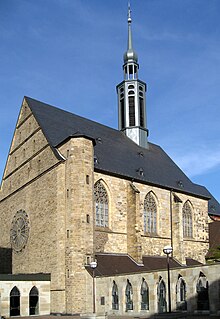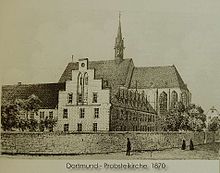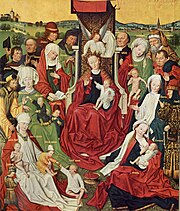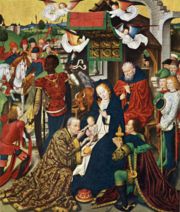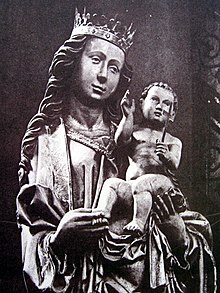Provost church of St. Johannes Baptist
The Propsteikirche St. Johannes Baptist is one of the four inner-city churches in Dortmund . The church is located south of Westenhellweg and west of Hansaplatz . It is the only Roman Catholic church within the Dortmund Wallring.
history
Dominican monastery
The Dominican Order , founded in 1215, tried several times from 1309 to settle in Dortmund. However, this did not succeed at first, and the religious were repeatedly expelled. In 1330 this finally succeeded and the Dominican monastery was founded as the third monastery in the imperial city of Dortmund. Between 1331 and 1353 the order then erected a first church building .
This church was designed as a three-bay choir with a 5/8 end . After completion, the church was consecrated in 1354. The church was soon expanded. The addition of an asymmetrical, three-aisled, three-bay nave to the Gothic hall church began in 1404, initially without a vault. The north aisle was made considerably narrower. After the completion of the vault, the church was consecrated in 1458. The late Gothic building was built in the style of a mendicant order church without a church tower. The primary purpose of being the place of prayer of the monastery community corresponds to the almost identical length ratio of the choir and nave.
Albert Ludorff describes the structure in 1894 as follows:
“The north aisle is very narrow with a barrel vault. Star vaults in the central nave; in the south aisle, choir and sacristy cross vaults with ribs and keystones. Rectangular pillar facing north with pillar templates in the side aisle, with round services in the central nave. To the south, pillars each with four round services, there and in the choir round wall services. Buttresses unadorned. "
In 1521 the sacristy , the present day devotional chapel, was vaulted.
The Dominican monastery was abolished in 1816 as a result of secularization .
Roman Catholic Parish Church
During the Reformation, all four inner-city churches in Dortmund became Protestant. Around 1800 the other two monasteries fell into disrepair and in 1819 St. Johannes Baptist became the first Catholic parish church in Dortmund after the Reformation. The church was elevated to the status of provost church in 1859 . The former monastery buildings were used as a rectory and school building.
The art historian Wilhelm Lübke was born in the school building of the Propsteihof on January 17, 1820 . A memorial stone on the former teacher's house reminds of this.
During industrialization and the associated influx of mainly Roman Catholic workers from the east, the number of parishioners rose sharply. The congregation grew to about 30,000 members. In order to better manage the parishioners , there were numerous parishes . The first new foundation that emerged from the Propsteigemeinde was the nearby Liebfrauenkirche . Before the Second World War, the community had 12,000 members.
The provost of the community was instrumental in founding the St. Johannes Hospital in the mid-19th century .
During the Second World War, the church was destroyed in bombing raids on downtown Dortmund in 1943, except for the surrounding walls. However, the church's most important art treasures had previously been relocated so that they survived the war. The church was rebuilt between 1947 and 1964.
In connection with the reconstruction in 1954, today's roof turret, made as a steel structure, was placed on the historic site. Since then there have been four bells in it, the tone of which is coordinated with the other churches in the city center.
Only parts of the east wing of the original three-winged monastery building, which was built between 1331 and 1428, and its outbuildings, such as the brewery, bakery and mill, have survived. This was restored between 1947 and 1966 after being destroyed in the Second World War.
The Propsteigemeinde operates a senior citizens' home and the Liebfrauen kindergarten in cooperation with the Liebfrauengemeinde and the Christinenstift.
As part of the construction of the Roman Catholic Center, the south wing and the north cloister were renewed in 1982.
On September 1, 2005, the top of the tower with weathercock was renewed. The new, around seven meters high and 350 kilograms heavy stainless steel construction consists of a ball, cross and weather valve and was lifted onto the church building with the help of a helicopter.
The church is registered with the parish and residential building as a monument in the list of monuments of the city of Dortmund .
Art treasures
Altar of Derick Baegert
One of the outstanding art treasures of the provost church is a late Gothic high altar reredos by the Wesel painter Derick Baegert from the 70s of the 15th century. The oldest image of the city of Dortmund can be found in the background on the left panel. The altar, which is 7.80 meters wide and 2.30 meters high, impresses with its wealth of figures and the abundance of realistic-style scenes.
The left wing represents the holy clan , a total of 25 men and women. In a green, gently rolling landscape in front of a castle and the skyline of Dortmund, the named figures are grouped around the throne of St. Mary with the baby Jesus . On the back of the panel there is, among other things, the donor figure of the Dominican prior Johann von Asseln .
The large, middle panel (width: 3.90 meters) shows the crucifixion scene against the background of an impressive city backdrop, according to Rolf Fritz the Jerusalem temple . On the left, behind a group around Saint Veronica with the handkerchief, is a self-portrait of the painter, after Elisabeth Baxhenrich-Hartmann the oldest known self-portrait of a painter in north-western Europe. In the background, the story of the crucifixion up to the descent from the cross and burial is told in small scenes.
In the center of this tablet is the cross with the dead Jesus. Blood flows from the lance in the side. Maria Magdalena clasps the cross, whose realistic anchoring with wedges in a stone setting catches the eye. In the background is a large group of armed men in richly decorated robes, some on horseback. In contrast to the unconscious, sinking Maria and her helpers, the group of warriors seems uninvolved and does not seem to register what is happening. The middle group is delimited by the crosses of the two co-convicts, the evil thief on the left and the repentant thief on the right. The sky behind the scenes, executed in a shining gold background, highlights the city backdrop and a chain of hills lined with windmills. To the right of the crucifixion scene, the mercenaries who are throwing the dice for Jesus' property get into an argument and attack each other with knives.
The right wing shows the adoration of the three kings. In front of a stylized stable is the holy family , surrounded by the kings with their gifts. The mounted entourage approaches from the medieval landscape in the background, armed and sometimes playing musical instruments. Small angel figures float over Mary and the child and carry a canopy.
In 1851/1852 Johann Friedrich Welsch extensively restored the three-winged altar panels.
More Attractions

Also worth mentioning is a fragment of a reredos of the Rosary Brotherhood of the Cologne Master Hilgardus from 1523. In the church there is also a donation board from the 15th century and a gradual from the 14th century.
The statue of Our Lady with the child comes from the Cologne carver workshop of the master Tilman . It was developed by Hans Peter Hilger still Tilman van der Burch attributed and dated an origin before 1480th The 1.57 meter high figure in the late Gothic style stands in the north aisle. Originally it was erected on the south central pillar of the central nave.
The statue is overall in good condition , except for minor damage to the socket . As the photo by Ludorff shows, in the 19th century the child carried a cross in his left hand. According to Rinke, the back of the figure is hollowed out and closed with a curved board. Possibly the version was renewed in the 19th century.
The lively posture of the earthly and heavenly figure of Mary in the style of a Hodegetria catches the eye . The rich folds of the dress and the coat emphasize the posture. The unclothed Christ Child seems to be looking at the viewer. The long hair that oozes out from under the crown of lilies symbolizes the virginity of Mary.
Another statue of the Virgin Mary of unknown origin is located on a pillar of the western main nave. According to R. Fritz, it was created around 1420 in the tradition of the Beautiful Madonnas. The 1.03 meter high figure shows only remnants of the original gilding and setting. The arms of the baby Jesus are missing, Mary's crown is also damaged and was originally higher. According to Wolfgang Rinke, the figure was restored to an unknown extent in the Museum Cappenberg in 1948.
The posture of the figure reflects the traditional Hodegetria Madonna type. The crown and remains of a scepter show Mary as Queen of Heaven . The heavy coat has remains of dark red painting on the edges. Mary's body and face appear rustic and rather plump. The oversized ear of the baby Jesus facing the viewer is striking.
Since 1982 the provost church has been holding a relic of a bone piece of Saint Reinoldus , who returned to Dortmund on the occasion of the 1100th anniversary.
organ
The organ of the church, built in 1988 by the organ builder Siegfried Sauer , is often used for concerts. The organ represents the type of the universal organ and has 52 registers , divided into three manuals and pedal . It has a mechanical action action and mechanical-electrical coupling . So far, two CD productions have been recorded on the Sauer organ. In 2015 the organ was renovated by Orgelbau Mühleisen (Leonberg); In the course of this, three sub-octave and one super-octave coupling were added, and the disposition was slightly revised. The previous 64-fold setter combination was replaced by a much more extensive one.
|
|
|
|
||||||||||||||||||||||||||||||||||||||||||||||||||||||||||||||||||||||||||||||||||||||||||||||||||||||||||||||||||||||||||||||||||||||||||||||||||||||||||||||||||||||||||||||||||||||||||
-
Pairing :
- Normal coupling: II / I, III / I, III / II, I / P, II / P, III / P
- Octave coupling: Sub III / I, Sub III / II, Sub III / III, Super III / III
- Playing aids : electronic setting system over 1,000,000 times
- annotation
- (N) = Register added in the course of restoration in 2015 (Mühleisen, Leonberg)
Bells
In the roof turret houses four bells of the Bochum Association from 1952. The big bell ( St. Mary , h 0 ) depends on bottom, about 2 Bell ( St. Joseph , cis 1 ) and that the two small bells 3 and 4 ( St. Johannes Baptist , e 1 and St. Dominicus fis 1 ) side by side.
literature
- Elisabeth Baxhenrich-Hartmann, Derick Baegert's high altar in the Provost Church of Dortmund, studies on the art and Dominican history of Dortmund in the 2nd half of the 15th century, Dortmund 1984
- Rolf Fritz, Museum for Art and Cultural History Dortmund , Derick Baegert, high altar of the Provost Church Dortmund, Dortmund 1963
- Hans Peter Hilger, The Marienleuchter and other late Gothic sculptures in the Propsteikirche in Dortmund, in: Westfalen, 1975, pp. 100–129
- Albert Ludorff: The architectural and art monuments of the Dortmund city district. Munster 1894
- Oliver Neumann: The Dortmund Propsteikirche - A historical picture sheet, Dortmund 1992, ISBN 3-7932-5081-4
- Theodor Rensing, The Dortmund Dominican Monastery (1309–1816), Münster 1936
- Norbert Reimann, Dortmund-Dominikaner, in: Westfälisches Urkundenbuch, Vol. 1, Münster 1992, pp. 261–268.
- Wolfgang Rinke: Dortmund churches of the Middle Ages. Dortmund 1991, ISBN 3-7932-5032-6
- Wolfgang Rinke: The altar in the provost church in Dortmund - history, art history, description of images. Cramers Kunstanstalt, Dortmund 1992. ISBN 3-924302-53-7
- Wolfgang Rinke: Memoria in the picture: The altar-retable of Derick Baegert from Wesel in the provost church of Dortmund. Bielefeld 2004.
- Thomas Schilp, Barbara Welzel: The Dortmund Dominicans in the late Middle Ages and the provost church as a place of remembrance. Publishing house for regional history. Bielefeld 2006. ISBN 3-89534-628-4
Web links
- http://www.propsteikirche-dortmund.de/
- Document registers from the archive of the Dominican monastery in Dortmund / Digital Westphalian document database (DWUD)
- The full bells of the Roman Catholic Provost Church of St. Johannes Baptist in Dortmund
Individual evidence
- ↑ No. A 0375. List of monuments of the city of Dortmund. (PDF) (No longer available online.) In: dortmund.de - Das Dortmunder Stadtportal. Monument Authority of the City of Dortmund, April 14, 2014, archived from the original on September 15, 2014 ; accessed on June 12, 2014 (size: 180 kB). Info: The archive link was inserted automatically and has not yet been checked. Please check the original and archive link according to the instructions and then remove this notice.
- ^ Rolf Fritz, Derick Baegert, high altar of the Propsteikirche Dortmund, p. 14.
- ↑ Elisabeth Baxhenrich-Hartmann, Derick Baegert's high altar in the Provost Church in Dortmund, p. 115.
- ↑ Hans Peter Hilger, The Marienleuchter and other late Gothic sculptures in the provost church in Dortmund, pp. 122–127.
- ↑ a b c Wolfgang Rinke, Dortmund Churches of the Middle Ages, p. 130.
- ↑ Information about the organ on the municipality's website
- ^ Dortmund, Propsteikirche: Bell 2 (cis'). Retrieved March 30, 2014 .
Coordinates: 51 ° 30 ′ 49 ″ N , 7 ° 27 ′ 46 ″ E
